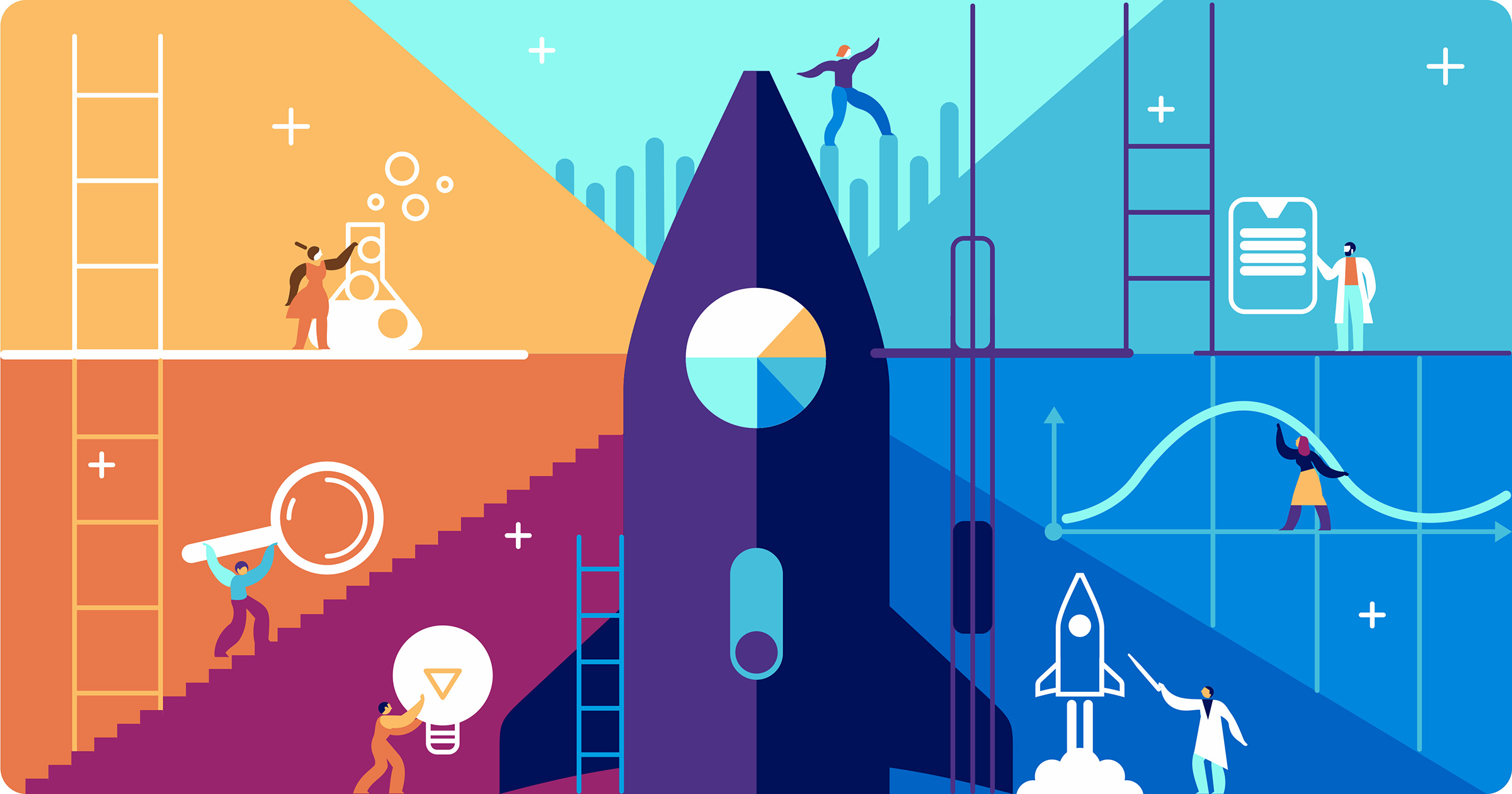
Steve Jobs said that people who are crazy enough to think they can change the world are the ones who do.
But crazy by itself isn’t enough to guarantee your new product will be successful. Only by understanding your customers, the market, your competitors, offering a product with clear value, and knowing how to implement it into reality will you be able to beat the odds.
When working with raw ideas, our team follows a new product development process based on some best practices and our own experience. This development process aims to transform new and untested concepts into viable products with decent traction on the market.
How does new product development differ?
A regular product development life cycle mainly relies on data a team gets from users, market, and product analytics. In comparison, new product development can’t rely on any empirical information. The time necessary for a new product to acquire first loyal users and gain stable traction is the time of constant research, surveys, building and testing hundreds of assumptions and hypotheses.
Such uncertainty can scare off some businesses. However, developing a brand new product provides a range of opportunities and benefits.
Peculiarities of the new product development process
Like any new initiative, new product development is an opportunity to start fresh and establish effective processes from the very beginning. Here are some of the main advantages you can gain when building a structured and well-weighed product development process:
- Building an innovative culture. New products require new ideas. Creating a culture of innovation, where everyone can share ideas no matter their role and seniority, can help a business see new perspectives.
- Keeping pace with your customers. Due to volatile economies and many other reasons, customers’ habits continually change. A well-built product development process allows for keeping pace with the time and ensures a solution is relevant.
- Discovering new opportunities. The product discovery techniques, that we describe later in this post, help investigate the problem context comprehensively, detect hidden patterns, see the picture from all possible angles, and find opportunities to grow your business. Don’t underestimate the power of a thorough product discovery session with the right discovery tools.
- Providing customers with more significant value. Before the development, a thorough analysis and research will help you to design a product that better matches your customers’ needs.
- Speeding up time to market. A balanced new product development process helps prioritize customer and business needs and cut everything that doesn’t bring value.
- Avoiding common pitfalls. A time-tested development process lets you avoid such pitfalls as investing too much into ideas that aren’t viable, solving the wrong problem, releasing the product too early or too late, failing to communicate the product value to your customers, targeting the wrong audience, not having enough flexibility to adapt and change your plans based on feedback or market situation.
New product development process step by step
For 15 years, the Railsware team has developed its own software products and helped clients reach their business goals by creating products with and for them. We worked on dozens of projects, and every case gave us invaluable experience and knowledge necessary for launching and growing successful solutions. With time, we perfected our approach to product development – be it SaaS product development or traditional – and ensured its efficiency. Here are the six stages of the new product development process at Railsware.
Ideation & Discovery with BRIDGeS
The aim of this stage is to validate a business problem we want to solve with a new solution, shape the vision of a future product, and make sure it can be implemented under given conditions.
There are a lot of tools you can use for this step. We, at Railsware, created our own product discovery framework – BRIDGeS to form the backbone of a new solution and maximize its chances to reach the product-market fit.
BRIDGeS is specifically designed to investigate the problem’s context from many different angles, visually simplify complex data, process it, and form a vision of an optimal solution knowing the risks and pitfalls in advance. Let’s have a quick look at how we use BRIDGeS for idea generation in new product development.
Problem discovery
We start with collecting as much data on a business problem as possible to understand its context and validate it. Often, the results of the investigation redirect us back to the start because:
- the problem is already solved by someone else,
- the problem is a part of a more complex issue,
- the market segment for the solution in question is very small to nonexistent.
Before the BRIDGeS discovery session, we consult subject-matter experts, run market research, perform competitor analysis, and gather any domain knowledge that can help us describe the business problem.
We display all the collected data as cards in the Problem Space. This approach adds visual clarity to the process and helps us save time.
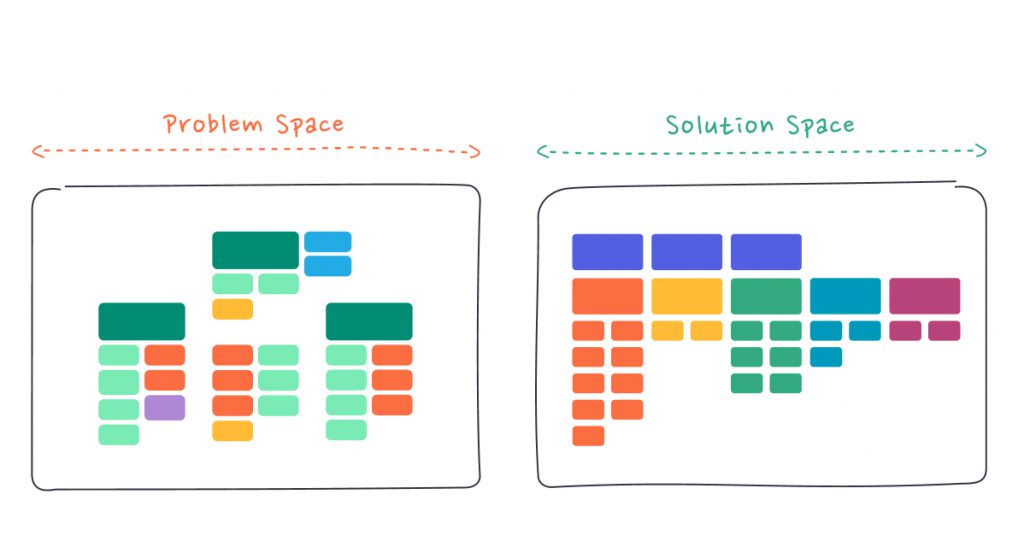
After that, we prioritize every piece of the context to narrow down the focus to the most critical aspects. Here’s how a complete Problem space may look like.
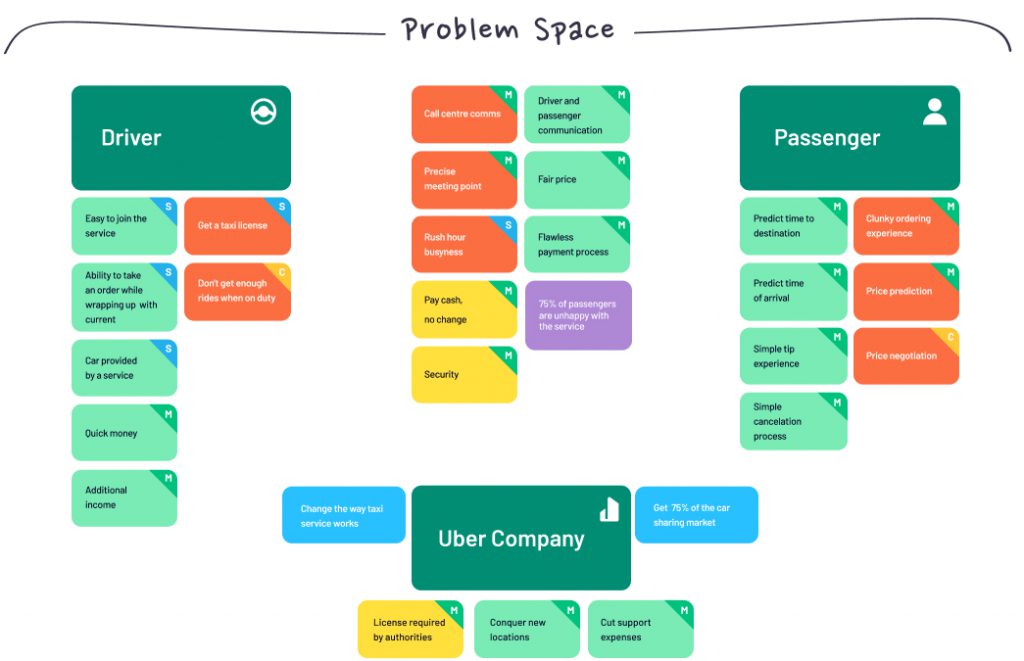
Check out the “Uber” case study, where we observe Uber’s idea in a time when this service didn’t exist and apply BRIDGeS for product discovery.
Solution variations and breakdown
Having all the critical information in front of us, we can now think about a solution that would satisfy the most essential requirements. This process is performed in the Solution Space.
To form a product vision, we first focus on several Solution variations that can meet the main objectives from the Problem Space. Then, we break down a variation we believe is the most optimal one into smaller manageable pieces (epics and tasks).
For example, in the case of Uber, we can think of the following potential solution: a web app, a universal mobile app for drivers and passengers, and separate mobile apps for two types of users. After an investigation, we realize that two separate mobile apps is the most optimal option. We deprioritize our solution into epics and tasks.
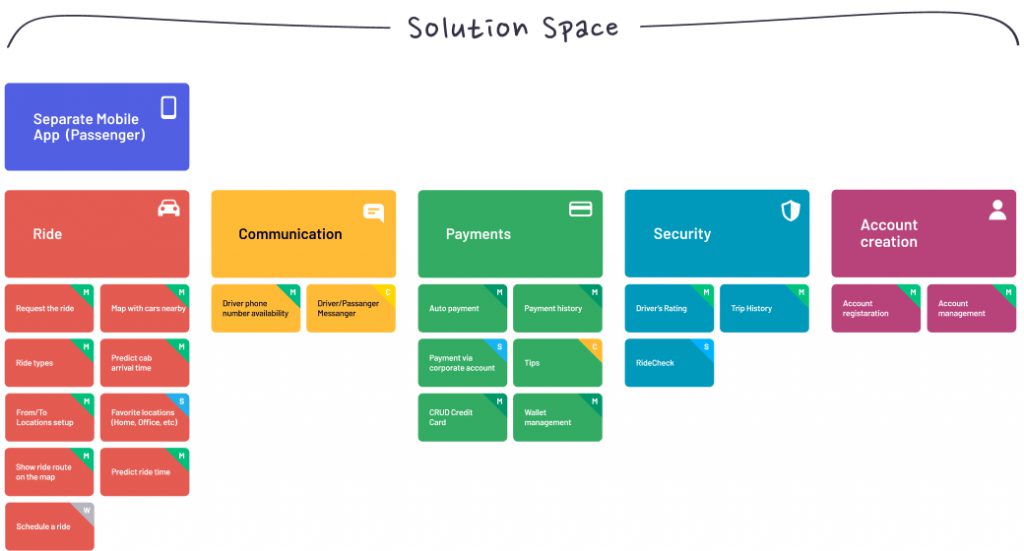
Next, we prioritize our further steps and create a product development roadmap for the product implementation.
BRIDGeS is a powerful and versatile tool using which, we get a clear product strategy, product roadmap, and a team aligned with all the contexts after only a 2-day session.
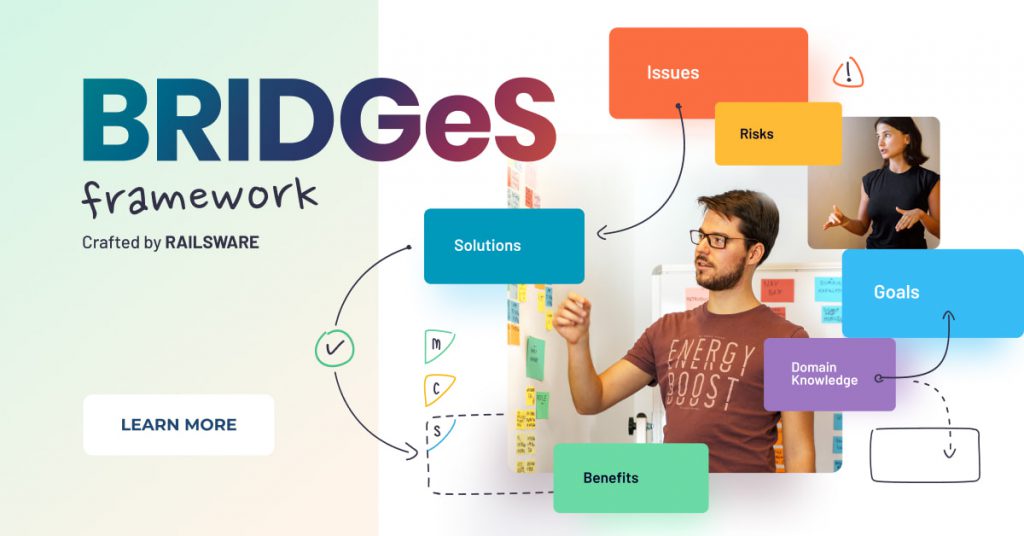
Let’s look at the roles involved in the Ideation & Discovery phase. Bear in mind that one specialist can take several roles. For instance, engineers, designers, and other team members can participate in testing, or a product manager can take some marketing responsibilities.
| Roles | Product Managers | Marketing specialists | Developers | Product Designers |
|---|---|---|---|---|
| Level of involvement* | 5 | 2 | 1 | 2 |
| Responsibilities | - Collect all the necessary data. - Initiate and run a discovery session. - Facilitate prioritizing solutions. - Organize session deliverables. Afterwards, share the roadmap and vision with other team members. | - Run market research. - Shape the target audience. - Participate in a session. Share domain knowledge. - Discuss marketing strategy and target audience characteristics. - Build hypotheses about the future product. | - Participate in a session. Share domain knowledge. - Advice on complexity and feasibility of solutions. - Advice on possible solutions. - Prioritize and estimate tasks. | - Participate in a session. Share domain knowledge. - Share best practices from existing solutions. - Prioritize and estimate tasks. |
*0-5 scale where 0 means no involvement, 5 means maximal involvement
Prototyping & Validation
The development of a prototype or a proof of concept has three main goals:
- Make sure a product can be built.
- Validate hypotheses about a product with real users.
- Use the gained knowledge to create the right thing from the first attempt, saving a significant amount of time and money.
When working with prototypes, we focus on testing the product hypotheses. We don’t go deep into the details, as solutions are most likely to be changed or rejected.
With the feedback from the right audience, we either prioritize improvements and move on to the next stage, or get back to the ideation.
| Roles | Marketing specialists | Product Managers | Developers | Product Designers |
|---|---|---|---|---|
| Level of involvement* | 2 | 5 | 3 | 5 |
| Responsibilities | - Use received data to shape the buyer persona and messaging, note pain points. - Collaborate with a team to analyze collected feedback and sort out product assumptions. | - Decide with the team what prototypes will be created. - Introduce prototypes to the target audience and collect feedback. - Analyze feedback and map the further steps. | - Build proof of concept if necessary. - Develop prototypes if they require any coding skills. | - Brainstorm the best way to test product hypotheses via prototypes. - Design prototypes. |
*0-5 scale where 0 means no involvement, 5 means maximal involvement
Initial development
During the initial development, our team creates a solid foundation for the future product. We meticulously choose the tech stack, think through the architecture, and create design skeletons for the solution ensuring its stable work, scalability, and maintainability in the future.
| Roles | Product Managers | Developers | Product Designers | Quality assurance |
|---|---|---|---|---|
| Level of involvement* | 5 | 5 | 5 | 1 |
| Responsibilities | - Set goals. - Maintain the process. - Ensure the team follows the product roadmap. - Monitor time and budget. | - Choose the most suitable tech stack. -Think through the architecture. - Develop essential functionality. | - Think through the design system. - Create essential layouts. | - Ensure a new solution works as expected. |
*0-5 scale where 0 means no involvement, 5 means maximal involvement
Alpha/Beta stages
We don’t recommend that you skip the Alpha and Beta stages, if you want to create a product that users really need and will be willing to pay for.
During this stage, we introduce the product to a limited target audience and onboard them in person. This way, we collect vital feedback that will be used to correct the development direction (if needed) and, what’s even more important, we gain first loyal users who can become the product’s advocates over time.
| Roles | Product Managers | Developers | Product Designers | Quality assurance engineers | Data Analysts | Marketing specialist | Support team |
|---|---|---|---|---|---|---|---|
| Level of involvement* | 5 | 5 | 5 | 3 | 2 | 2 | 3 |
| Responsibilities | - Attracts first users and onboards them. - Validate product hypotheses. | - Polish the system and ensure its stability. - Fix the found issues. | - Polish the design system, tweak it if necessary using user feedback. | - Catch critical and major bugs. | - Collect first product analytics. | -Interview first users to get unbiased feedback, work with assumptions, and collect ideas for the product improvement. - collect ideas for marketing strategies. | - Support first users. |
*0-5 scale where 0 means no involvement, 5 means maximal involvement
Minimum Viable Product
The main difference between a Beta version of a product and an MVP is that the latest one should operate sustainably and smoothly to be introduced to a larger audience. The launch requires efforts from the marketing team focused on promotion. Apart from that, specialists at Railsware utilize a range of marketing techniques such as interviewing customers (CustDev), research, polls, and surveys to measure a product-market fit.
| Roles | Product Managers | Developers | Product Designers | Quality assurance engineers | Data Analysts | Marketing specialists | Support team |
|---|---|---|---|---|---|---|---|
| Level of involvement* | 5 | 5 | 5 | 5 | 5 | 5 | 3 |
| Responsibilities | - Ensure a product is ready to launch. - Develop rollout strategies. -Participate in users' onboardings. - Work with users and stakeholders to define further steps, decide what features to develop next. | - Stabilize the solution. - Promptly react to detected bugs. | - Improve the solution based on feedback. | - Run various tests to ensure stable operation of the solution. | - Collect product metrics and analyze them. | - Work on promotion via multiple channels. - Define messaging and main selling points. - Look for partnerships. - Analyze how marketing campaigns perform compared to competitors’. | - Timely react to customers' requests. |
*0-5 scale where 0 means no involvement, 5 means maximal involvement
The concepts of PoC, prototype, and MVP are usually used interchangeably even though that’s not accurate. For more of a deep dive into their differences, check out our blog.
Growing product
Growing a brand new product is challenging as you work with a non-confirmed audience and market and don’t have a large loyal audience yet. To ensure stable product growth, our team collects as much information as possible and adjusts product strategy on the go. We test assumptions, confirm the target audience, encourage word of mouth, and work on user acquisition – you can even use user acquisition agency services if you need help. We also correct the Value Proposition if it’s needed, and much more.
After a product launch, we check how it performs, collect metrics, and run CustDev sessions to use this knowledge in the next iteration. All this data helps us form new product hypotheses that we test using the BRIDGeS framework.
| Roles | Product Managers | Developers | Product Designers | Quality assurance specialists | Data Analysts | Marketing specialists | Support |
|---|---|---|---|---|---|---|---|
| Level of involvement* | 5 | 5 | 5 | 5 | 5 | 5 | 5 |
| Responsibilities | - Work with collected data to find growth opportunities. - Ensure that the current product works smoothly. - Optimize the team processes for growth. | - Work on new features. - Improve product scalability and ease of adding new features. | - Work on new features. | - Test new functionality. - Automate testing and facilitate a delivery process. | - Collect and analyze product metrics. - Analyze customers' behavior. - Analyze competitors' metrics. | -Improve the conversion. -Maintain tight contact with customers to get regular feedback. - Look for new audiences and markets and new promotion channels. | - Provide full support to all customers. Collect users’ feedback to use it as an asset for further product growth. |
*0-5 scale where 0 means no involvement, 5 means maximal involvement

Examples of the new product development process
Let’s consider some hypothetical and simplified examples to catch the idea of the process. The last example showcases a real product developed by the Railsware team.
Example 1 – Electrifying
Imagine rechargeable vehicles don’t exist yet, and you’re responsible for each of the new product development stages.
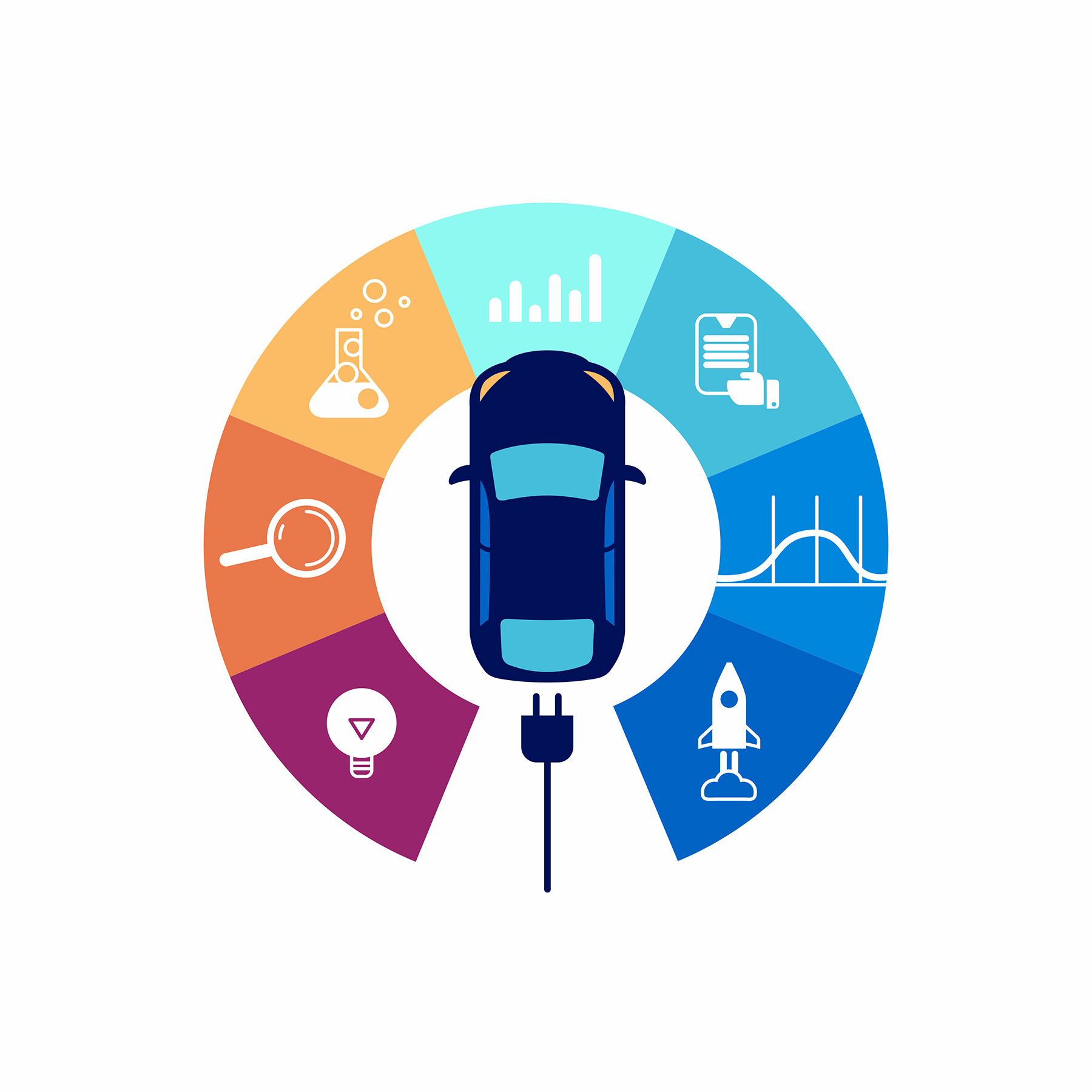
Stage 1 Ideation & Discovery
While working in the automobile industry you see that more and more families refuse traditional cars for environmental reasons. So you’ve come up with the idea to create the world’s first electric car.
At first, you need to check if it’s a real problem and if there might be a market for your solution.
After collecting a lot of data and analyzing the needs of your target audience, you think about solutions that can potentially solve the problem. These can be electric cars, electric public transport, bicycles, etc.
The collected information and the results of a discovery session showed that the electric car is the best option for the target audience.
Stage 2 Prototyping & Validation
You developed an electric car’s computer model as a proof of concept. Now you know that the solution can be built and it will be reasonably priced.
You show the model to the target audience and see that it strongly resonates with people looking for an alternative to oil-powered cars — both for cost savings and environmental friendliness.
Stage 3 Initial Development
You start the development of the world’s first electric car. You collaborate with engineers, designers, and many other specialists who form the skeleton of the future car.
Stage 4 Alpha/Beta stages
The first sample is ready. You show it to customers, ask them to do a test drive, and share their feedback. You allow people to keep the car for a month so that they can test it long-term and feel the difference.
You collect pre-orders for your car.
Stage 5 MVP
The feedback from those first customers allows you to fix detected issues and add the most requested features. The car has everything users need to satisfy their most essential needs. You’ve comprehensively tested the car and ensured its safety.
After selling the first 100 electric cars, you constantly collect customers’ feedback and monitor the market to map the further development plan.
Stage 6 Product growth
You introduce your brand new car at the Paris Motor Show or New York Auto Show to boost brand awareness. You see that there are many other groups of people interested in your car, so you decide to expand the product line and create luxury electric cars, minivans, and hatchbacks.
Example 2 – What’s Cooking?
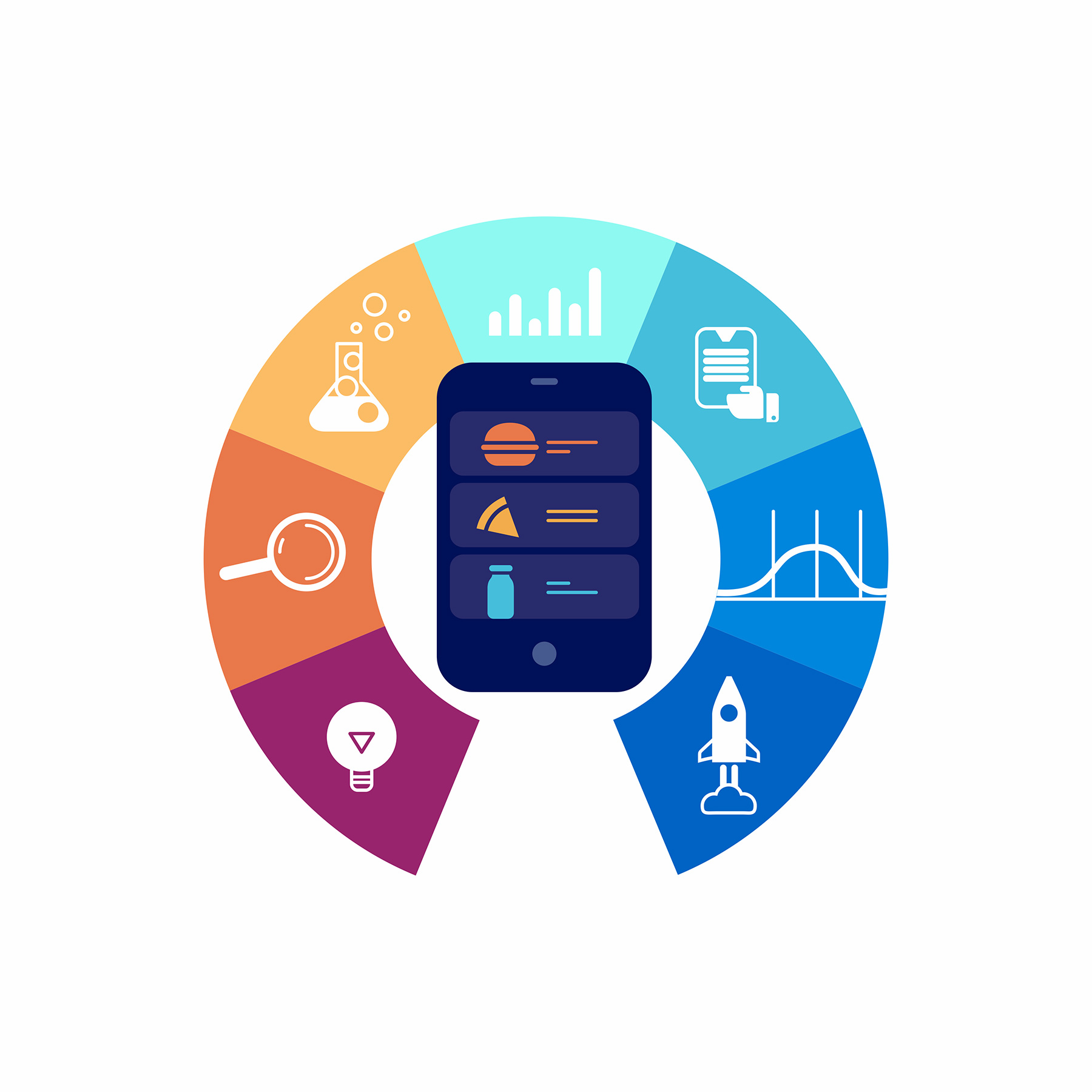
In the second example, let’s imagine you’re creating a new meal delivery app with some unique features.
Stage 1 Ideation & Discovery
There are some food delivery apps on the market, but you believe they lack two features that can significantly add to the whole customer experience:
- A quick-purchase option for people who are too hungry to think.
- A dietary restriction setting that would automatically remove meals containing ingredients a customer is allergic to.
You check FAQ sections on the site of existing apps, analyze customers’ reviews on various sites, and run surveys to collect data on the problem. Additionally, you can incorporate Likert scale examples in your surveys to gather quantitative insights, allowing respondents to rate their experiences and opinions on a defined scale.
When discussing how to implement those features with your team, you realize that it makes sense to release a product with only the first unique feature, as restricting meals according to dietary needs would require too many resources and efforts, especially with so many partners.
Then, you run surveys and research and create a landing page to promote the quick-purchase option and see how many customers would be interested in it.
Stage 2 Prototyping & Validation
You create several clickable prototypes and show them to potential customers to ensure that this is really what customers are excited about, the solution solves their pain, the design is intuitive, and all flows work well.
Stage 3 Initial development
Your team works on the main flow to pre-select a category and immediately get your food ordered and creates a lightweight app that can be launched.
Stage 4 Alpha/Beta stages
The product is usable enough, and you launch it in a limited area (one district in your city). You collect customers’ feedback and understand that people lack a feature to repeat their past orders, also you see that some food categories can be omitted (it’s unlikely that a hungry person orders fusion or molecular cuisine).
Stage 5 MVP
The app is stable and has no critical bugs. You release it for users in your city and then your country. You see, there are a lot of sign-ups, but users hesitate to do their first orders. After several CustDev interviews, you find out that people don’t understand how much they will be charged. You release a new feature that allows users to set the budget range.
Stage 6 Product growth
To expand a customer base, you offer bonuses, prizes, and discounts to your users, start an affiliate program, and attract influencers.
The customers’ feedback guides you. You know exactly what functionality they need in new releases and having the product development process in place, you can safely experiment with the new features. These can be “order food sets for hungry groups of people”, “food to watch a football game”, or “food for a housewarming party,” etc.
Now, let’s look at the real example of how we created a simple scheduling solution for our client from scratch.
Example 3 – Hassle-free appointment booking
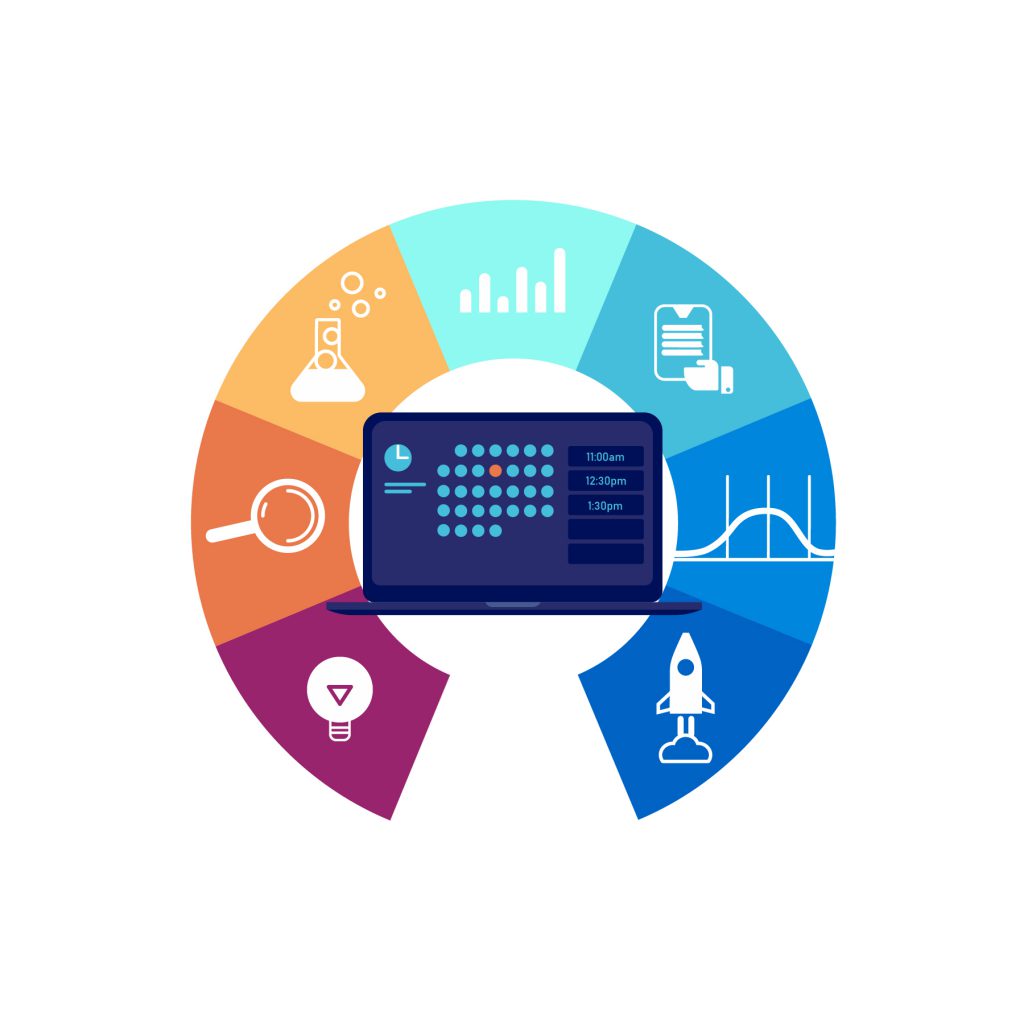
Calendly is an appointment-making tool that simplifies the booking process both for service providers and customers. To use the tool, a service provider creates an account that synchronizes with their calendar. Then, the provider sets time frames available for appointments. The provider generates a link that can be sent to any customer who then finds an available slot and books a meeting.
Needless to say, the platform is beneficial for all sorts of businesses, starting from sales people, sports clubs, restaurants, medical workers, lawyers, and other consultants. The tool allows getting rid of back-and-forth communication, booking confirmation, and manual appointment rescheduling, which often takes too much time and effort.
Now, let’s look back at how we developed this product.
Stage 1 Ideation & Discovery
The idea of the product belongs to our client Tope Awotona, an experienced entrepreneur who noticed the pain of a lot of businesses and decided to create a solution that can mitigate it.
We started with the two-day BRIDGeS session. During the session, we investigated the context of the problem and defined the most critical aspects of the future product. These were simplicity, intuitiveness, and integration with the Google Calendar.
The prioritization during the BRIDGeS session allowed us to narrow our focus to essential features for the first release. This way, we decided that the first version would have registration, account creation, integration only with Google Calendar, setting availability preferences, link generation, and the ability to book an appointment for invitees.
The scope that wasn’t necessary but rather nice-to-have was scheduled for the second and third releases, e.g.corporate accounts, integrations with other popular calendars, multi-person meetings, etc.
Stage 2 Prototyping & Validation
Together with developers, designers, marketing and product managers, we decided on how we would test our product hypotheses. We created several clickable prototypes and evaluated them with the potential users.
Stage 3 Initial development
As was mentioned before, the first release of the product included only the most essential features that could help individuals and businesses solve the issue of a long and tiring scheduling process in a few clicks.
Stage 4 Alpha/Beta stages
When the product’s first version was ready, we offered Tope Awotona, Calendly founder, to test it on real customers but in a small and controlled environment.
At that time, our team was closing a deal with an educational startup. We sent them Calendly as our recent development. The startup founders liked the idea and they began to book meetings with schools via Calendly. After exposing Canedly to those schools, they, in turn, also enjoyed the solution, signed up, and started to set up appointments with their contacts using the tool. This is how things blew up 😎.
Stage 5 MVP
After polishing the product and testing it, we released an MVP. The initial release of Calendly is a perfect example of a basic product that solves a huge and widespread problem while including very few features.
When the product was launched, we saw its massive adoption and planned further development based on user feedback and new requirements.
Stage 6 Product Growth
When Calendly gained a significant base of active users and showed exponential growth of new customers, our team started working on advanced features and launched several paid plans. The advanced functionality included automated communication scenarios before and after meetings, voting, polls, the ability to connect several calendars to one account, and many others.
Conclusion
Obviously, every team has its own development flow tailored to its needs and realities, even though the main steps are the same for everyone. Often, teams change the flow due to the project’s specificity. For instance, we can sometimes start with the CustDev interviews and then move on to the prototyping stage.
Anyway, no matter what you call the stages or how many of them you distinguish in your new product development process, the only thing to remember is that each of them should be focused on producing greater customer value and innovation. This is how you’ll ensure your product is a success.
